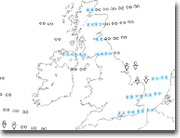Numerical weather prediction uses current weather conditions as input into mathematical models of the atmosphere to predict the weather. Although the first efforts to accomplish this were done in the 1920s, it wasn't until the advent of the computer and computer simulation that it was feasible to do in real-time. Manipulating the huge datasets and performing the complex calculations necessary to do this on a resolution fine enough to make the results useful requires the use of some of the most powerful supercomputers in the world. A number of forecast models, both global and regional in scale, are run to help create forecasts for nations worldwide. Use of model ensemble forecasts helps to define the forecast uncertainty and extend weather forecasting farther into the future than would otherwise be possible.
Wikipedia, Numerical weather prediction,
http://en.wikipedia.org/wiki/Numerical_weather_prediction(as of Feb. 9, 2010, 20:50 UTC).






















